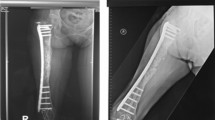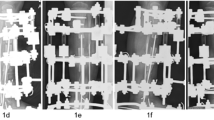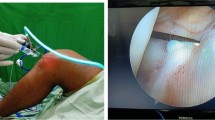Abstract
Introduction
Most patients with congenital pseudoarthrosis of tibia (CPT) do not have promising outcomes despite multiple attempts using conventional surgeries. The combination of umbilical cord-derived mesenchymal stem cells and conditioned medium (secretome) contains major components pivotal for the enhancement of fracture healing. The purpose of this study was to address fracture healing in CPT cases that were treated using the combined implantation of umbilical-cord mesenchymal stem cells (UC-MSCs) and secretome.
Materials and Methods
From 2016 to 2017, six patients with CPT who were treated by one senior pediatric orthopedic consultant at a single center (3 girls and 3 boys; mean age of 5.8 years) were included in this case series. A combined procedure including resection of hamartomatous fibrotic tissue, implantation of MSCs and secretome, and fixation using a locking plate and screws was performed. Patients were followed up for a mean of 29 months. Leg-length discrepancy, refracture rate, functional outcome, and radiological outcomes were assessed preoperatively, immediately postoperatively and at the final follow-up.
Result
Five out of 6 (83%) of the patients experienced primary union. One patient experienced refracture; however, 8 months later, after another implantation and reconstruction were performed, union eventually occurred. Significant functional improvement was achieved after at least 1 year of follow-up.
Conclusion
This case series suggests that the combination of secretome and UC-MSCs is a potential treatment for CPT, it highlights the efficacy of the combined procedure in treating CPT and in achieving satisfying results. A larger number of subjects and longer follow-up are required for further study.





Similar content being viewed by others
References
Agha RA, Borrelli MR, Farwana R, Koshy K, Fowler AJ, Orgill DP (2018) The PROCESS 2018 statement: updating consensus preferred reporting of CasE series in surgery (PROCESS) guidelines. Int J Surg 60:279–282. https://doi.org/10.1016/j.ijsu.2018.10.031
Cho T, Seo J, Hr L, Wj Y, Cy C, Ih C (2008) Biologic characteristics of fibrous hamartoma from congenital pseudarthrosis of the tibia associated. J Bone Joint Surgery Am 90:2735–2744. https://doi.org/10.2106/JBJS.H.00014
Das SP, Ganesh S, Pradhan S, Singh D, Mohanty RN (2014) Effectiveness of recombinant human bone morphogenetic protein-7 in the management of congenital pseudoarthrosis of the tibia: a randomised controlled trial. Int Orthop 38(9):1987–1992. https://doi.org/10.1007/s00264-014-2361-7
Dilogo IH, Mujadid F, Nurhayati RW, Kurniawan A (2018) Evaluation of bone marrow-derived mesenchymal stem cell quality from patients with congenital pseudoarthrosis of the tibia. J Orthop Surg Res 9:9–16
Dobbs MB, Rich MM, Gordon JE, Szymanski DA, Schoenecker PL (2005) Use of an intramedullary rod for the treatment of congenital pseudarthrosis of the tibia. J Bone Joint Surg– Ser A 87(SUPPL. 1):33–40. https://doi.org/10.2106/00004623-200503001-00003
Dohin B, Kohler R (2012) Masquelet’s procedure and bone morphogenetic protein in congenital pseudarthrosis of the tibia in children: a case series and meta-analysis. J Children’s Orthop 6(4):297–306. https://doi.org/10.1007/s11832-012-0421-3
Donnell CO, Foster J, Mooney R, Beebe C, Donaldson N, Heare T (2017) Congenital pseudarthrosis of the Tibia. JBJS Rev 5(4):1–12
Giannoudis PV, Einhorn TA, Marsh D (2007) Fracture healing: the diamond concept. Injury 38(4 SUPPL.):11–12. https://doi.org/10.1016/S0020-1383(08)70003-2
Horn J, Steen H, Terjesen T (2013) Epidemiology and treatment outcome of congenital pseudarthrosis of the tibia. J Children’s Orthop 7(2):157–166. https://doi.org/10.1007/s11832-012-0477-0
Ismail HD, Phedy P, Kholinne E, Djaja YP, Kusnadi Y, Merlina M, Yulisa ND (2016) Mesenchymal stem cell implantation in atrophic nonunion of the long bones: a translational study. Bone Joint Res 5(7):287–293. https://doi.org/10.1302/2046-3758.57.2000587
Katagiri W, Osugi M, Kawai T, Hibi H (2016) First-in-human study and clinical case reports of the alveolar bone regeneration with the secretome from human mesenchymal stem cells. Head Face Med 12(1):1–10. https://doi.org/10.1186/s13005-016-0101-5
Kim HO, Choi S, Kim H (2013) | Feature article | mesenchymal stem cell-derived secretome and microvesicles as a cell-free therapeutics for neurodegenerative disorders. Tissue Eng Regen Med 10(3):93–101. https://doi.org/10.1007/s13770-013-0010-7
Marsell R, Einhorn TA (2011) The biology of fracture healing. Injury 42(6):551–555. https://doi.org/10.1016/j.injury.2011.03.031
Oetgen ME, Richards BS (2010) Complications associated with the use of bone morphogenetic protein in pediatric patients. J Pediatric Orthop 30(2):192–198. https://doi.org/10.1097/BPO.0b013e3181d075ab
Ohnishi I, Sato W, Matsuyama J, Yajima H, Haga N, Kamegaya M, Minami A, Sato M, Yoshino S, Oki T, Nakamura K (2005) Treatment of congenital pseudarthrosis of the Tibia. J Pediatric Orthop 25(2):219–224. https://doi.org/10.1097/01.bpo.0000151054.54732.0b
Paley D (2006) Congenital pseudarthrosis of the Tibia. Curr Progr Orthop, NA. 247:317–348. https://doi.org/10.1097/00003086-198910000-00008
Pannier S (2011) Congenital pseudarthrosis of the tibia. Orthop Traumatol Surg Res 97(7):750–761. https://doi.org/10.1016/j.otsr.2011.09.001
Patwa J, Patel R (2013) A short series of congenital pseudoarthrosis tibia. J Orthop 10(3):123–132. https://doi.org/10.1016/j.jor.2013.07.002
Pawitan JA (2014) Prospect of stem cell conditioned medium in regenerative medicine. Biomed Res Int 2014:1–14. https://doi.org/10.1155/2014/965849
Pawitan JA, Liem IK, Budiyanti E, Fasha I, Feroniasanti L, Jamaan T, Sumapradja K (2014) Umbilical cord derived stem cell culture: multiple-harvest explant method. Int J PharmTech Res 6(4):1202–1208. https://doi.org/10.1371/journal.pcbi.1003775
Richards BS, Oetgen ME, Johnston CE (2010) The use of rhBMP-2 for the treatment of congenital pseudarthrosis of the Tibia: a case series. J Bone Joint Surg- Ser A 92(1):177–185. https://doi.org/10.2106/JBJS.H.01667
Vander Have KL, Hensinger RN, Caird M, Johnston C, Farleya F (2008) Congenital pseudarthrosis of the tibia. J Am Acad Orthop Surg 16(4):228–236. https://doi.org/10.1016/j.rcot.2009.12.008
Funding
This research was funded by the postgraduate research grant Universitas Indonesia (Grant number: 01/PKS/IPT/INSENTIF/IV/2019).
Author information
Authors and Affiliations
Corresponding author
Ethics declarations
Conflict of interest
None.
Additional information
Publisher's Note
Springer Nature remains neutral with regard to jurisdictional claims in published maps and institutional affiliations.
Rights and permissions
Springer Nature or its licensor (e.g. a society or other partner) holds exclusive rights to this article under a publishing agreement with the author(s) or other rightsholder(s); author self-archiving of the accepted manuscript version of this article is solely governed by the terms of such publishing agreement and applicable law.
About this article
Cite this article
Kurniawan, A., Ivansyah, M.D., Dilogo, I.H. et al. Umbilical cord mesenchymal stem cells combined with secretome for treating congenital pseudarthrosis of the Tibia: a case series. Eur J Orthop Surg Traumatol 33, 2881–2888 (2023). https://doi.org/10.1007/s00590-023-03511-3
Received:
Accepted:
Published:
Issue Date:
DOI: https://doi.org/10.1007/s00590-023-03511-3




